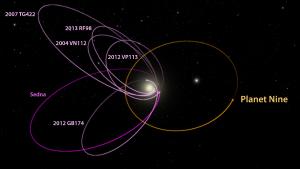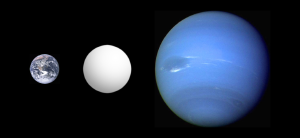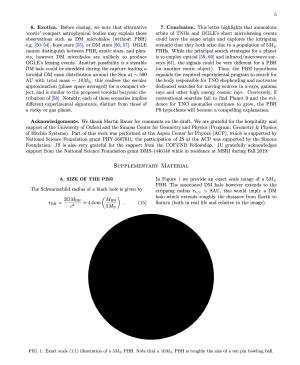Blog
A Faint and
Distant Pull
24 May 2020
 CalTech/R. Hurt (IPAC)
CalTech/R. Hurt (IPAC)There are eight classical planets in our solar system, from speedy Mercury to distant Neptune. There are also numerous dwarf planets, such as Pluto and Ceres. While we continue to find more dwarf planets, there are some hints that another large planet could lurk far beyond Neptune. This Planet Nine is thought to be a “super-Earth” about five times the mass of our planet, which would make it about twice as large as Earth.1 But despite several searches for the planet, it has not yet been found.
 Wikipedia
WikipediaMaybe we haven’t found Planet Nine because it doesn’t exist. Evidence for the planet is not very strong. It stems from a statistical analysis of the orbits of small bodies in the outer solar system. The idea is that the gravitational pull of Planet Nine causes the orientation of their orbits to cluster. But as others have pointed out, the observed clustering could be due to other effects.2
If Planet Nine exists, it’s a bit odd that we haven’t found it. Several sky surveys are sensitive enough to see a planet of its size. It’s possible that the planet is more distant than we expect, or has a lower albedo, but observations are starting to rule some of these out. There is, however a much more radical idea. What if Planet Nine hasn’t been observed because it isn’t a planet? What if it is a primordial black hole?
 Jakub Scholtz and James Unwin
Jakub Scholtz and James UnwinPrimordial black holes are hypothetical objects formed during the early moments of the big bang. If they exist they would have the mass of a planet rather than a star. If Planet Nine is a primordial black hole, then it would be about the size of an apple.3 This would make it far too small and dark to find with our current telescopes. However, since it would still pull on nearby objects gravitationally, there might be other ways to find it.
One way would be to send a fleet of tiny space probes toward its predicted general direction. In a new paper,4 Edward Witten argues that spacecraft about 100 grams in mass could be programmed to transmit a regularly timed signal. If any of them get in the range of the black hole, the signals would be dilated by its gravity.
The downside of this approach is that the spacecraft would need to time their signals with atomic clock precision, and there are currently no atomic clocks small enough to fit on a 100-gram probe. A different team has proposed an alternative, where the probes instead sent a simple signal, and high-resolution radio telescopes measure the shift of their trajectories.5 But a third team argues that effects such as solar wind would overwhelm any gravitational effects.6
All of this is pretty wild speculation. If there is a planet lurking at the edge of our solar system, it almost certainly is not a black hole, which means it will be observed eventually. But sometimes in science, you need to rule out the wild ideas before you can find the right one.
Batygin, Konstantin, and Michael E. Brown. “Evidence for a distant giant planet in the solar system.” The Astronomical Journal 151.2 (2016): 22. ↩︎
Volk, Kathryn, and Renu Malhotra. “The curiously warped mean plane of the Kuiper belt.” The Astronomical Journal 154.2 (2017): 62. ↩︎
Scholtz, Jakub, and James Unwin. “What if Planet 9 is a Primordial Black Hole?.” arXiv preprint arXiv:1909.11090 (2019). ↩︎
Witten, Edward. “Searching for a Black Hole in the Outer Solar System.” arXiv preprint arXiv:2004.14192 (2020). ↩︎
Lawrence, Scott, and Zeeve Rogoszinski. “The Brute-Force Search for Planet Nine.” arXiv preprint arXiv:2004.14980 (2020). ↩︎
Hoang, Thiem, and Abraham Loeb. “Can Planet Nine Be Detected Gravitationally by a Sub-Relativistic Spacecraft?.” arXiv preprint arXiv:2005.01120 (2020). ↩︎